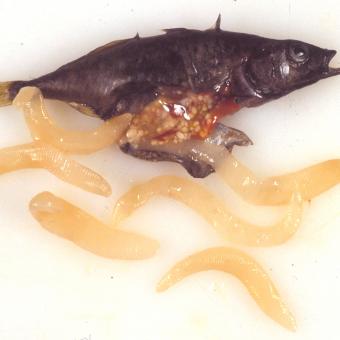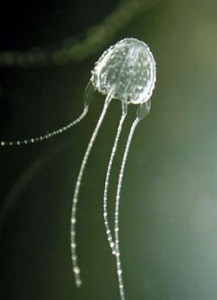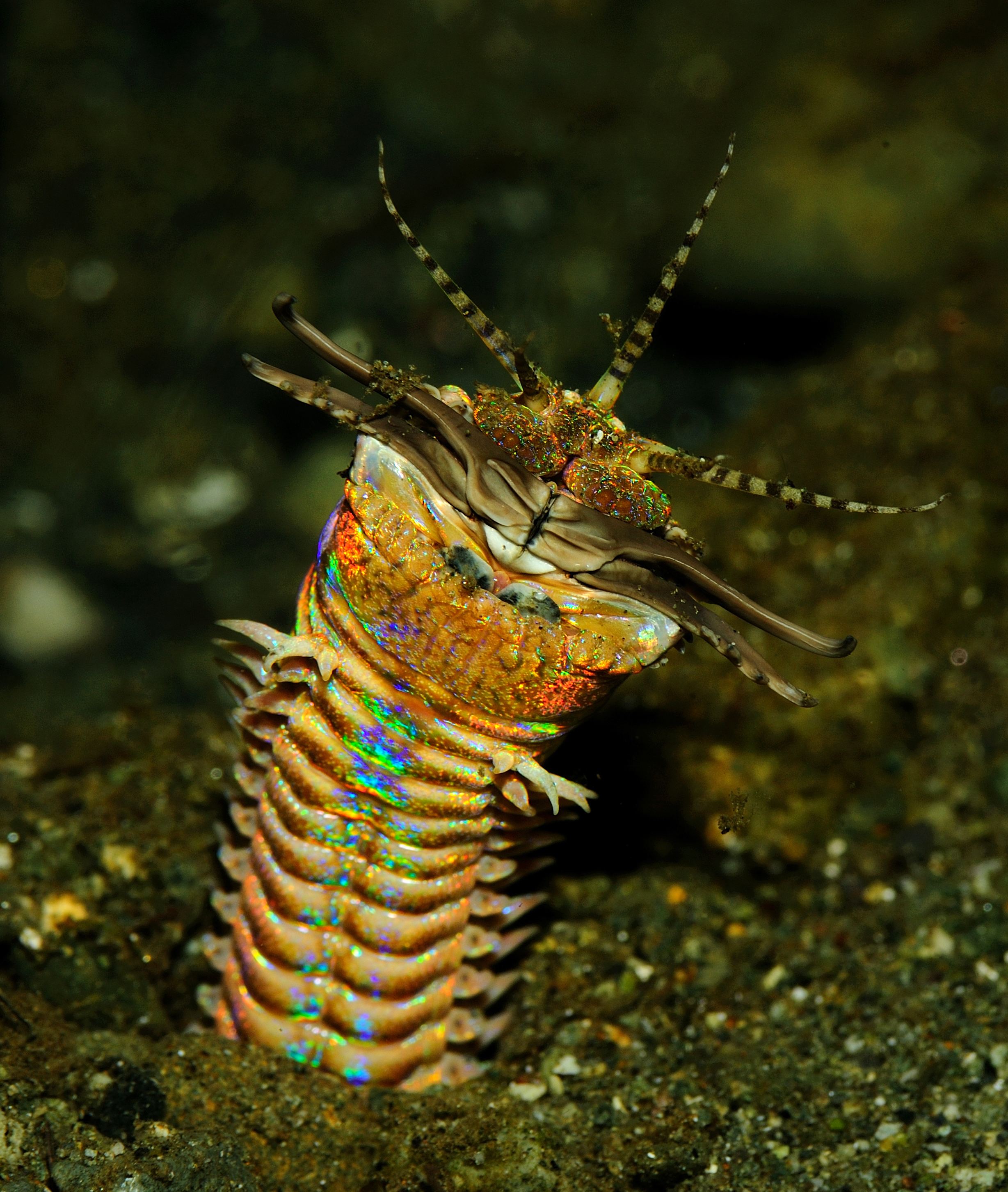Evolution is infinitely creative. Sometimes, amid the beauty and wonder, the awe that emanates from the shear power of natural selection, and the poetry of descent with modification, evolution produces something that terrifies. I am not talking about our natural predators, for whom fear is part of our evolutionary heritage, but rather creatures that appear as though they emerged from our darkest nightmares. But even our nightmares are limited by our finite minds.
Evolution has no such limits and the immense size and incomprehensible diversity of the oceans has produce animals that make us yearn for the comforting familiarity of the common Pumpkinhead. Submitted for the approval of the Midnight Society, I present six sea monsters that make their horror movie counterparts look tame:
1. These mind-bending tapeworms crawled straight out of Slither.
Here is a classic horror movie scenario for you: alien/parasite/mutant invaders enter your body, latch on to you brain, and take control, forcing you to do their bidding as they multiply and infect those around you. From Body Snatchers to Slither, mind-controlling parasites are a mainstay of the genre. But you’re a reader of Southern Fried Science. You already know all about barnacles that take over crab brains and induce sex-changes when necessary or fungi that invade ants and force them to climb to their doom. Mind control parasites aren’t really all that uncommon, but they mostly infect invertebrates. There aren’t any deadly mind-melting monsters that can take over us higher organisms, right? Right?!
Wrong.
Schistocephalus solidus is a cestode parasite that makes its home in fish, seabirds, and rodents, but it is among fish that it’s mind-melting powers are most apparent. S. solidus infects sticklebacks, where larval parasites grow and develop before being delivered into the bellies of waiting seabirds for reproduction. These parasites need warm temperatures to maximize their growth, temperatures that are warmer than most sticklebacks enjoy. So what does S. solidus? It alters the behavior of the fish, forcing them to seek out warmer waters. This behavior lets the worm grow larger and increases their reproductive output while their host, deprived of nutrients due to the massive worms living inside it, slowly wastes away. These sickly sticklebacks are now perfect prey for the parasites’ next host.
Oh, and one more thing. When you open up an infected stickleback, this is what comes out:

2. This fear-inducing cubozoan might just be It.

Franklin Delano Roosevelt said “We have nothing to fear but fear itself.” Clearly, he never met Pennywise, the horrible clown-star of Stephen King’s It. This movie could scare the chromatophores off a Kraken and it did so by using one of the most reliable tools of the horror genre. ‘It’ induces fear in it’s prey by assuming the form of their deepest fears. ‘It’ literally harnesses “fear itself” to destroy its victims.
It might very well be a cubozoan.
No, I’m not talking about the legendary sea wasp — a box jelly that packs some of the most potent venom in the ocean — but rather its diminutive cousins, Carukia barnesi and Malo kingi, two species with venom so painful that both their scientific names derive from their victims. Their venom is, fortunately, rarely fatal. The initial sting has often been compared to a mosquito bite, while the symptoms — excruciating pain in the muscles, back, and kidneys, headaches, nausea, vomiting, and possibly cardiac arrest — can take hours to emerge. Your skin may feel like it is burning. You can see why people might be afraid of these thumbnail-sized animals.
But ‘It’ isn’t just scary, ‘It’ preys on the fears of its victims. ‘It’ induces fear. Painful stings are not sufficient to place one on par with Pennywise the Clown.
Both Carukia barnesi and Malo kingi are Irukandji Jellies — their sting induces symptoms that are collectively referred to as Irukandji Syndrome. Among the most unusual aspects of this syndrome is that envenomation triggers a release of catecholamines — hormones like epinephrine, norepinephrine, and dopamine –resulting in a disconcertingly ambiguous flight-or-fight response. Stinging victims report an intense feeling of impending doom. A sting from an Irukandji jelly makes you fear for your life, and you won’t know why.
Oh, and unlike almost all other jellies, Irukandji jellies have stinging cells on their bells. Why? Because no one is safe from It.
httpv://www.youtube.com/watch?v=rNJC0FI4aSs#t=12
3. This Antarctic predator could go head-to-everscible-head with the Alien xenomorph.
I know what you’re thinking and I’m just going to stop you there. It’s not Phronima.
“But,” you might ask, “the xenomorph is practically based off Phronima! There’re even rumors that H.R. Giger used it as his inspiration!”
Tough luck. It is not Phronima.
“You can’t do that! Phronima is always the alien Alien from Alien and Aliens! You can’t have a ‘marine animals that resemble movie monsters’ list without Phronima!”
You appear to be confused. This is not a ‘marine animals that resemble movie monsters list’. This is a ‘sea monsters that make their horror movie counterparts look tame’ list, and, at 2.5 cm long, Phronima sedentaria just doesn’t cut it. Everyone’s favorite amphipod may look the part, but the tiny titan that murders salps so that it can lay its eggs in their hollowed out carcasses and swim around wearing corpses like a house just doesn’t have the chops. It can’t extrude an everscible proboscis that bores into the bodies of its victims. It can’t secrete acidic mucus that burns through floors and kills anything bold enough to approach it. It can’t burrow into it’s victims body, only to burst out at a later date.
In short, it isn’t this:
httpv://www.youtube.com/watch?v=HG17TsgV_qI
Parborlasia corrugatus, an Antarctic nemertean worm, can grow more the 2 meters long and hunts by stabbing its prey repeatedly with a harpoon-like proboscis. When it finds a rich food supply, like a large animal carcass, it burrows inside to feast on the soft parts. When the oxygen gets low, it can stretch and compress its body, increasing its surface area to allow more efficient gas exchange. It has no major predators, because it secretes an acidic mucus to deter attackers. How acidic? The mucus has a pH of 3.5. A pH of 3.5 is the high end of human stomach acid.
Better luck next time, Phronima.
4. These ravenous invaders could out-eat Critters‘ Krites.
What’s small, roundish, pointy, colorful, invasive, and exists only to eat? If you guessed the alien Krites from Critters, you would be right, but seeing as this is a marine science and conservation blog, you can bet that I probably have something else in mind.
And, since you read Southern Fried Science and watch Blue Pints, you’ve probably already guessed that I’m talking about the pretty invasive with an ugly appetite, the Lionfish.
For those of you not paying attention, lionfish were introducd to the US East Cast sometime in the early 1990’s. Since then, their populations have exploded. Lionfish can now be found as far north as New York state. They are incredibly fecund in their adoptive habitat, able to out-compete native fishes for resources. With no natural predators in this new range, there is almost nothing to keep their population in check. A recent study by graduate student Christie Wilcox revealed thick layers of interstitial fat inside these invasive gluttons — lionfish outside their native range are obese. Generally speaking, fish shouldn’t be obese.
Here’s the Blue Pints episode where we discuss Christie’s research:
httpv://www.youtube.com/watch?v=ZCDgPjz9dv0
5. Adorable and murderous? That’s Child’s Play to this cuddly creature.
[UPDATE] Ken Peterson of the Monterrey Bay Aquarium informs me that, though the rumor persists, Flamboyant Cuttlefish are actually not particularity toxic [/UPDATE]
I love cuttlefish. Seriously. While my branchial hearts will always belong to the noble squid, cuttlefish still hold the title of most adorable cephalopod. Metasepia pfefferi, or Pfeffer’s flamboyant cuttlefish for those on a common name-basis, is no exception.

This huggable mollusk hides a deadly secret. Metasepia pfefferi is one of only three cephalopods that are toxic. This animal’s flesh is a potent as the blue ringed octopuses venom — 10,000 times more toxic than cyanide — that causes blindness and total paralysis, if you are lucky. For the unlucky, death from poisoning can occur in minutes. Eating flamboyant cuttlefish is not advised.
A combination of adorable innocence and the ability to unimaginable pain and death places Metasepia pfefferi on equal footing with one of my first, and still favorite campy horror monsters, the murderous doll, Chucky, start of the Child’s Play franchise.
6. You will learn a new definition of pain and suffering in this worm’s jaws.

Everyone was talking about the awkwardly named Bobbit Worm last week. Eunice aphroditois is a beautiful, massive, predatory polycheate that waits, buried in the sand with only its head visible, for passing prey to brush against is sensitive antennae. Once triggered, it strikes with powerful jaws capable of capturing and even bisecting unwary animals. Prey is then drug beneath the surface for consumption. Some studies suggest that this creature releases a necrotizing toxin to kill and digest its prey.
This worm can grow up to 3 meters long, though most are much smaller. Watching videos of it dragging fish into its burrow reminds me of another gigantic, partially buried (possibly) worm-like creature, the scourge of both Jedis and bounty hunters, the Sarlacc pit monster. Its shape and behavior isn’t the only thing that E. aphroditois and the Sarlacc have in common. Both have been incredibly over-hyped. Take a moment, those readers of the Star Wars expanded universe, and ask yourself “how many times was Boba Fett eaten by a creature so terrifying that Jabba the Hutt described being eaten by it with “In his belly, you will find a new definition of pain and suffering as you are slowly digested over a thousand years.”
The answer is three. Seriously. Ignoring the fact that Boba Fett is pretty over-hyped as a bounty hunter if he fell into the same desert murder hole on three separate occasions, how is death by Sarlacc the ultimate punishment if you can just climb, fly, or explode your way out?
So what’s the hype with the Bobbit worm? Let’s start with the name, which has been apocryphally linked to Lorena Bobbitt due either to the powerful nature of its jaws or a much less credible story about its reproduction (fact check: Bobbit worms have no reproductive structure that would closely resemble a penis, they probably reproduce through epitoky, and there is no evidence that they participate in genital cannibalism. More likely, the internet just likes the name Bobbit worm). They’ve had plenty of other common names, such as the Biting Reef Worm, which, while not poetic, is at least descriptive.
There are also rumors of poisonous bristles (perhaps due to confusion with the closely related fireworm). There is no evidence that these worms have toxic bristles or will paralyze a human who accidentally touches one. Bobbit worms are also fairly rare. They are not lying in wait in every crevice and on every sand flat, nor will you find them in every carelessly imported rock for your salt water aquarium.
Hype or no hype, Eunice aphroditois is an incredible, fascinating, (possibly) terrifying animal. Since I’m sure someone will ask this in the comments anyway, I’ll go ahead and posit the question: Who would win in a fight between a Bobbit Worm and a Lionfish.
Answer, it’s not the lionfish.
httpv://www.youtube.com/watch?v=3H4J5QDQeA4
Intentional Oversight: Jaws.
The shark from Jaws really is one of the scariest and most memorable movie monsters of all time. It’s probably responsible for more ongoing terror than any of the more fantastical creatures on this list. That almost certainly has to do with the fact that sharks are real creatures. Jaws isn’t supposed to be a fantastical creature of the Id, it’s a monster grounded in a genuine fear of a real, and really fearsome predator. So why didn’t Hollywood’s #1 nightmare make the list? Well, the Krites are pushovers compared to lionfish; bobbit worms are so powerful they sometimes accidentally cut their prey in half; Irukandji’s fear inducing venom can’t be overcome with the power of imagination. These are sea monsters that make their horror movie counterparts look tame. The shark from Jaws? Way more deadly than an actually shark.
This post is part four in the epic saga “Andrew makes lists of ridiculous organisms with tenuous pop-culture connections”. Read the others!